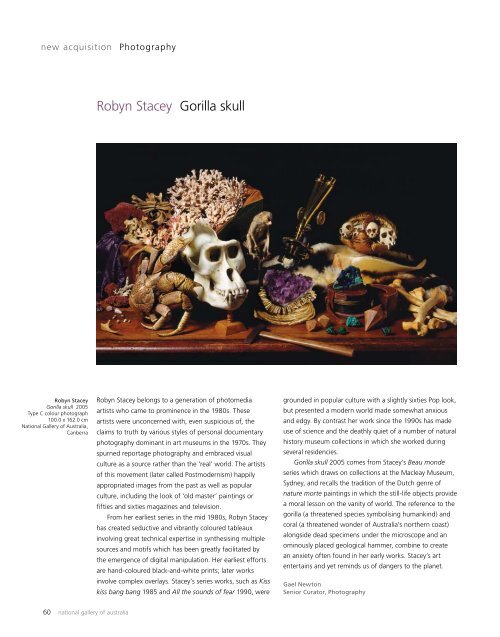Art Ew - National Gallery of Australia
Art Ew - National Gallery of Australia
Art Ew - National Gallery of Australia
Create successful ePaper yourself
Turn your PDF publications into a flip-book with our unique Google optimized e-Paper software.
new acquisition Photography<br />
Robyn Stacey<br />
Gorilla skull 2005<br />
Type C colour photograph<br />
100.0 x 162.0 cm<br />
<strong>National</strong> <strong>Gallery</strong> <strong>of</strong> <strong>Australia</strong>,<br />
Canberra<br />
60 national gallery <strong>of</strong> australia<br />
Robyn Stacey Gorilla skull<br />
Robyn Stacey belongs to a generation <strong>of</strong> photomedia<br />
artists who came to prominence in the 1980s. These<br />
artists were unconcerned with, even suspicious <strong>of</strong>, the<br />
claims to truth by various styles <strong>of</strong> personal documentary<br />
photography dominant in art museums in the 1970s. They<br />
spurned reportage photography and embraced visual<br />
culture as a source rather than the ‘real’ world. The artists<br />
<strong>of</strong> this movement (later called Postmodernism) happily<br />
appropriated images from the past as well as popular<br />
culture, including the look <strong>of</strong> ‘old master’ paintings or<br />
fifties and sixties magazines and television.<br />
From her earliest series in the mid 1980s, Robyn Stacey<br />
has created seductive and vibrantly coloured tableaux<br />
involving great technical expertise in synthesising multiple<br />
sources and motifs which has been greatly facilitated by<br />
the emergence <strong>of</strong> digital manipulation. Her earliest efforts<br />
are hand-coloured black-and-white prints; later works<br />
involve complex overlays. Stacey’s series works, such as Kiss<br />
kiss bang bang 1985 and All the sounds <strong>of</strong> fear 1990, were<br />
grounded in popular culture with a slightly sixties Pop look,<br />
but presented a modern world made somewhat anxious<br />
and edgy. By contrast her work since the 1990s has made<br />
use <strong>of</strong> science and the deathly quiet <strong>of</strong> a number <strong>of</strong> natural<br />
history museum collections in which she worked during<br />
several residencies.<br />
Gorilla skull 2005 comes from Stacey’s Beau monde<br />
series which draws on collections at the Macleay Museum,<br />
Sydney, and recalls the tradition <strong>of</strong> the Dutch genre <strong>of</strong><br />
nature morte paintings in which the still-life objects provide<br />
a moral lesson on the vanity <strong>of</strong> world. The reference to the<br />
gorilla (a threatened species symbolising humankind) and<br />
coral (a threatened wonder <strong>of</strong> <strong>Australia</strong>’s northern coast)<br />
alongside dead specimens under the microscope and an<br />
ominously placed geological hammer, combine to create<br />
an anxiety <strong>of</strong>ten found in her early works. Stacey’s art<br />
entertains and yet reminds us <strong>of</strong> dangers to the planet.<br />
Gael Newton<br />
Senior Curator, Photography

















